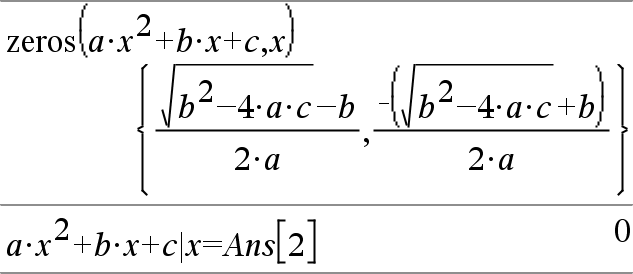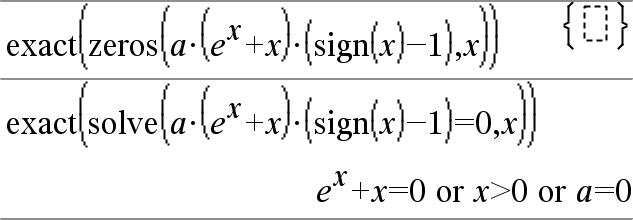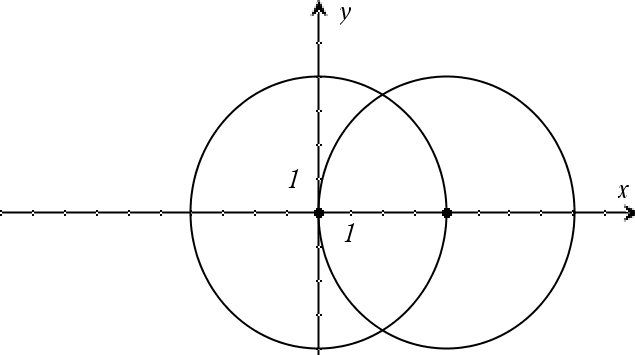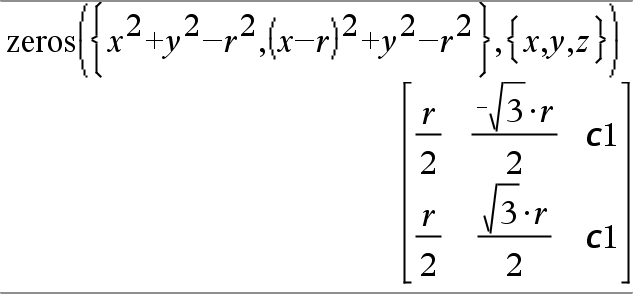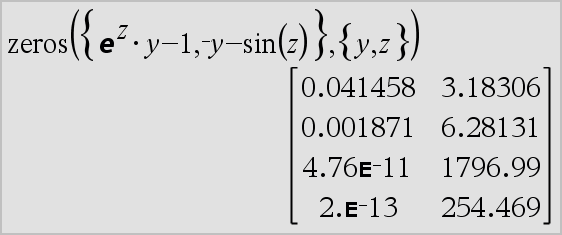|
Catalog > |
|
|
zInterval σ,List[,Freq[,CLevel]] (Data list input) zInterval σ,v,n [,CLevel] (Summary stats input) Computes a z confidence interval. A summary of results is stored in the stat.results variable. (See here.) For information on the effect of empty elements in a list, see “Empty (Void) Elements,” here. |
|
|
Output variable |
Description |
|
stat.CLower, stat.CUpper |
Confidence interval for an unknown population mean |
|
stat.x |
Sample mean of the data sequence from the normal random distribution |
|
stat.ME |
Margin of error |
|
stat.sx |
Sample standard deviation |
|
stat.n |
Length of the data sequence with sample mean |
|
stat.σ |
Known population standard deviation for data sequence List |
|
Catalog > |
|
|
zInterval_1Prop x,n [,CLevel] Computes a one-proportion z confidence interval. A summary of results is stored in the stat.results variable. (See here.) x is a non-negative integer. For information on the effect of empty elements in a list, see “Empty (Void) Elements,” here. |
|
|
Output variable |
Description |
|
stat.CLower, stat.CUpper |
Confidence interval containing confidence level probability of distribution |
|
stat.Ç |
The calculated proportion of successes |
|
stat.ME |
Margin of error |
|
stat.n |
Number of samples in data sequence |
|
Catalog > |
|
|
zInterval_2Prop x1,n1,x2,n2[,CLevel] Computes a two-proportion z confidence interval. A summary of results is stored in the stat.results variable. (See here.) x1 and x2 are non-negative integers. For information on the effect of empty elements in a list, see “Empty (Void) Elements,” here. |
|
|
Output variable |
Description |
|
stat.CLower, stat.CUpper |
Confidence interval containing confidence level probability of distribution |
|
stat.Ç Diff |
The calculated difference between proportions |
|
stat.ME |
Margin of error |
|
stat.Ç1 |
First sample proportion estimate |
|
stat.Ç2 |
Second sample proportion estimate |
|
stat.n1 |
Sample size in data sequence one |
|
stat.n2 |
Sample size in data sequence two |
|
Catalog > |
|
|
zInterval_2Samp σ1,σ2 ,List1,List2[,Freq1[,Freq2,[CLevel]]] (Data list input) zInterval_2Samp σ1,σ2,v1,n1,v2,n2[,CLevel] (Summary stats input) Computes a two-sample z confidence interval. A summary of results is stored in the stat.results variable. (See here.) For information on the effect of empty elements in a list, see “Empty (Void) Elements,” here. |
|
|
Output variable |
Description |
|
stat.CLower, stat.CUpper |
Confidence interval containing confidence level probability of distribution |
|
stat.x1-x2 |
Sample means of the data sequences from the normal random distribution |
|
stat.ME |
Margin of error |
|
stat.x1, stat.x2 |
Sample means of the data sequences from the normal random distribution |
|
stat.σx1, stat.σx2 |
Sample standard deviations for List 1 and List 2 |
|
stat.n1, stat.n2 |
Number of samples in data sequences |
|
stat.r1, stat.r2 |
Known population standard deviations for data sequence List 1 and List 2 |
|
Catalog > |
|
|
zTest μ0,σ,List,[Freq[,Hypoth]] (Data list input) zTest μ0,σ,v,n[,Hypoth] (Summary stats input) Performs a z test with frequency freqlist. A summary of results is stored in the stat.results variable. (See here.) Test H0: μ = μ0, against one of the following: For Ha: μ < μ0, set Hypoth<0 For information on the effect of empty elements in a list, see “Empty (Void) Elements,” here. |
|
|
Output variable |
Description |
|
stat.z |
(x − μ0) / (σ / sqrt(n)) |
|
stat.P Value |
Least probability at which the null hypothesis can be rejected |
|
stat.x |
Sample mean of the data sequence in List |
|
stat.sx |
Sample standard deviation of the data sequence. Only returned for Data input. |
|
stat.n |
Size of the sample |
|
Catalog > |
|
|
|
|
Output variable |
Description |
|
stat.p0 |
Hypothesized population proportion |
|
stat.z |
Standard normal value computed for the proportion |
|
stat.PVal |
Smallest level of significance at which the null hypothesis can be rejected |
|
stat.Ç |
Estimated sample proportion |
|
stat.n |
Size of the sample |
|
Catalog > |
|
|
zTest_2Prop x1,n1,x2,n2[,Hypoth] Computes a two-proportion z test. A summary of results is stored in the stat.results variable. (See here.) x1 and x2 are non-negative integers. Test H0: p1 = p2, against one of the following: For Ha: p1 > p2, set Hypoth>0 For information on the effect of empty elements in a list, see “Empty (Void) Elements,” here. |
|
|
Output variable |
Description |
|
stat.z |
Standard normal value computed for the difference of proportions |
|
stat.PVal |
Smallest level of significance at which the null hypothesis can be rejected |
|
stat.Ç1 |
First sample proportion estimate |
|
stat.Ç2 |
Second sample proportion estimate |
|
stat.Ç |
Pooled sample proportion estimate |
|
stat.n1, stat.n2 |
Number of samples taken in trials 1 and 2 |
|
Catalog > |
|
|
zTest_2Samp σ1,σ2 ,List1,List2[,Freq1[,Freq2[,Hypoth]]] (Data list input) zTest_2Samp σ1,σ2,v1,n1,v2,n2[,Hypoth] (Summary stats input) Computes a two-sample z test. A summary of results is stored in the stat.results variable. (See here.) Test H0: μ1 = μ2, against one of the following: For Ha: μ1 < μ2, set Hypoth<0 For information on the effect of empty elements in a list, see “Empty (Void) Elements,” here. |
|
|
Output variable |
Description |
|
stat.z |
Standard normal value computed for the difference of means |
|
stat.PVal |
Smallest level of significance at which the null hypothesis can be rejected |
|
stat.x1, stat.x2 |
Sample means of the data sequences in List1 and List2 |
|
stat.sx1, stat.sx2 |
Sample standard deviations of the data sequences in List1 and List2 |
|
stat.n1, stat.n2 |
Size of the samples |

